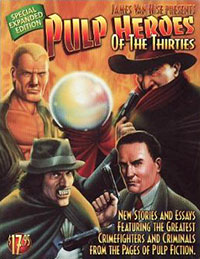 Probably few pulp fans today are familiar with James Van Hise. He has been a writer, editor, and publisher for many years within certain genres such as “Star Trek,” movie serials, The Green Hornet, comicbooks, and pulps.
Probably few pulp fans today are familiar with James Van Hise. He has been a writer, editor, and publisher for many years within certain genres such as “Star Trek,” movie serials, The Green Hornet, comicbooks, and pulps.
He was involved at times with publishing several Edgar Rice Burroughs fanzines and did the last run of the classic comic-book fanzine Rocket’s Blast Comicscollector.
In the late 1990s, he put out several large books collecting articles and artwork on the pulps. Sadly, these are out of print and getting hard to find. I was fortunate to get them when they came out, and if you look around, they are still available.
They collect new and reprinted articles by a range of people. In addition to articles by Van Hise himself, you will find articles by other pulp researchers like Will Murray and Tom Johnson. Many of the articles are reprinted from various pulp fanzines and magazines, like Tom’s Echoes, while others are original to these collections. There are also a few unexpected gems in these works.
The collections are:
- “Pulp Heroes of the Thirties” (1993, 1997)
- “PulpMasters” (1996, 2002)
- “Edgar Rice Burroughs’ Fantastic Worlds” (1996)
- “Pulp Magazine Thrillers” (1998)
- “The Fantastic Worlds of H.P. Lovecraft” (1999)
- “The Fantastic Worlds of Robert E. Howard” (2001)
“Pulp Heroes of the Thirties” was the first collection. It came out in 1993 and in 1997 was expanded with additional articles and a new cover. We get several articles on pulp heroes like The Shadow, Doc Savage, The Spider, G-8, and The Avenger by Will Murray, Don Hutchison, Tom Johnson, Robert Sampson, and more.
Some notable articles includes one organized by Murray in which he asks five other pulp researchers what they felt where the top 10 Spider novels (and a bad one). We also get a great article on the origin of The Avenger by Murray, and other on the ancestors of Batman. There is also an article on artist Margaret Brundage, who has recently been showcased in a book.
The bonus for this collection are two new stories of classic heroes. We get a new, authorized story of Operator #5, as well as a new, authorized Spider story. We would not see a new Spider story until Moonstone did their collection.
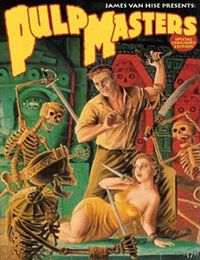 “PulpMasters” came next in 1996, with an expanded edition in 2002 with a new cover. There are articles on The Shadow, The Spider, as well as articles looking at lesser-known heroes like Captain Satan, The Black Hood, and several of Thrilling’s minor heroes. Some notable articles includes another one organized by Murray in which he asked other pulp researchers their top 25 Shadow novels (and a bad one).
“PulpMasters” came next in 1996, with an expanded edition in 2002 with a new cover. There are articles on The Shadow, The Spider, as well as articles looking at lesser-known heroes like Captain Satan, The Black Hood, and several of Thrilling’s minor heroes. Some notable articles includes another one organized by Murray in which he asked other pulp researchers their top 25 Shadow novels (and a bad one).
We get an article by Norvell Page, the author of many Spider novels, on “How I Write” taken from 1935. And there is a great article on Operator #5 by Murray that looks at the three phases of stories of this character. There is also an art portfolio of Shadow interior art by Edd Carter. Among the new articles are ones on Burroughs, Robert E. Howard, and an updated Lester Dent bibliography.
The final general collection was “Pulp Magazine Thrillers” in 1998. We get many similar articles as in the previous two collections. We now have an article organized by Murray with others on the top 10 Doc Savage novels. We have a few articles not on pulp heroes, but on Weird Tales, The Thrill Book, and sex and torture in the pulps. We get a old article by Dent from 1940. And we get articles on the Secret Six and the Phantom Detective. There is also an art portfolio of ERB pulp covers by J. Allen St. John.
There were then three collections focused on specific authors: Edgar Rice Burroughs, H.P. Lovecraft, and Robert E. Howard.
“Edgar Rice Burroughs’ Fantastic Worlds” came out in 1996, and is a collection of articles and artwork gathered into three sections. The source of many of these articles are various ERB related fanzines. The first is on the adventures, which focuses mainly on Tarzan, along with Barsoom (Burroughs’ Mars). The second section is on artistic interpretations that includes articles on artists like Russ Manning, Reed Crandall, and Thomas Yeates, among others. The third section is on Burroughs himself. The only dink on this collection was there was nothing on Burroughs’ other worlds like Venus or Pellucidar.
“The Fantastic Worlds of H.P. Lovecraft” was next in 1999. It has a wide range of articles on the works of Lovecraft, again taken from various fanzines. It even has a few articles by Lovecraft himself. Some articles look at Lovecraft’s mythology and influences. Others are more biographical, such as about his time living in New York. Others look at Lovecraft’s legacy. A couple examine his letters, as Lovecraft was an avid letter writer. There are some art portfolios as well, one looking at the artwork from Weird Tales, another the artwork of Allen Koszowski. Anyone who is more than a casual fan of Lovecraft would enjoy this collection.
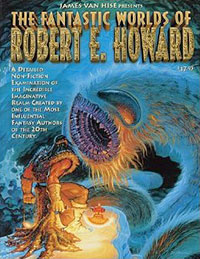 “The Fantastic World of Robert E. Howard” was the final collection in 2001. Like the others, it is a wide range of articles and artwork on the author of Conan and other pulp adventure stories take mainly from REHUPA, the Robert E. Howard United Press Association. In addition to articles on Conan, we get articles on other works of Howard, such as Almuric, Solomon Kane, Skull-Face and others. There are articles on Howard himself. And there are some interesting articles looking at some of the people who edited and “revised” Howard’s work: L. Spargue de Camp and Lin Carter. Like the other collections, this one is sprinkled with artwork from the pulps and modern age, including a portfolio of covers from German paperbacks.
“The Fantastic World of Robert E. Howard” was the final collection in 2001. Like the others, it is a wide range of articles and artwork on the author of Conan and other pulp adventure stories take mainly from REHUPA, the Robert E. Howard United Press Association. In addition to articles on Conan, we get articles on other works of Howard, such as Almuric, Solomon Kane, Skull-Face and others. There are articles on Howard himself. And there are some interesting articles looking at some of the people who edited and “revised” Howard’s work: L. Spargue de Camp and Lin Carter. Like the other collections, this one is sprinkled with artwork from the pulps and modern age, including a portfolio of covers from German paperbacks.
As noted, these are all, in my opinion, great collections. Sadly, they are out of print as only a limited number were printed (usually around a 1,000 copies per edition or printing). A few you can get for fairly reasonable prices, and some are still available from Van Hise through his eBay store.
I think in this day of print-on-demand that these could easily be reprinted through either Lulu or CreateSpace, and there may be a market. These books collect some great articles from various fanzines that probably haven’t been reprinted elsewhere, and deserve to be preserved. Otherwise, get your hands on them before they become too hard to find.

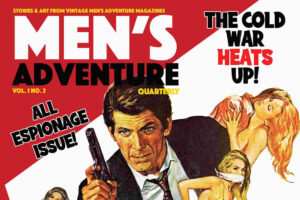
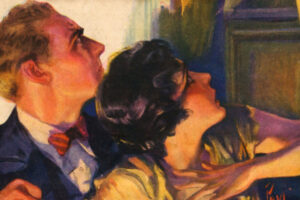

Your comments